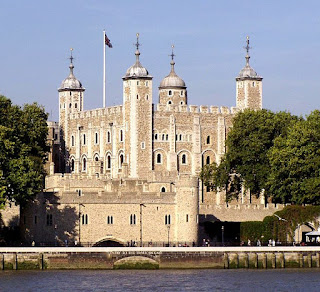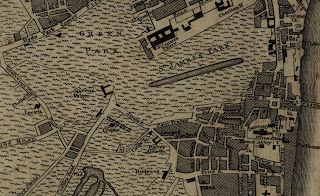The term for “soft drink” varies significantly across the United States. “Pop” is most often used in the Midwest and Northwest. People who use the word “soda” are most often found in the Northeast, Arizona, and California. Finally, “Coke” is commonly used to describe a soft drink in the South.
Monthly Archives: August 2009
Map of the Week! Connecticut Tribes Circa 1625
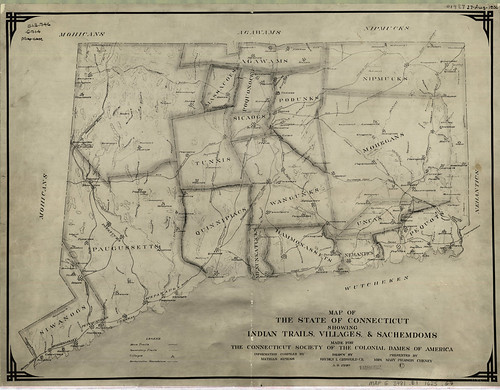
On this map made in 1930 we can see 19 Native American Sachemdoms of 1625 delineated in, and around the state of Connecticut. What exactly is a Sachemdom? It’s the territory of a Sachem. OK, so what exactly is a Sachem? A Sachem is the title of leadership in a Native American Tribe…so tying it all together a Sachemdom is the territory of a particular Native American Tribe under the leadership of Sachem. Got it?
So which 19 Sachemdoms are featured on our map? Here’s a list with links to informational websites. These sites are by no means the singular authorities on each tribe but it should make it easier for you to get a head start when gathering your own information!
Mohicans
Paugussetts
Siwanogs
Agawams
Massacoes
Tunxis
Quinnipiacs
Menunkatucks
Wangunks
Sicaogs
Poquonocks
Podunks
Hammonassets
Nehantics
Uncas
Mohegans
Nipmucks
Pequots
Wutcheken
Along with the tribe names listed above you will notice that there are major trails and pathways delineated on the map as well. What kind of impact do these trails and pathways have today? Examine the following map, toggle on the railroad layer located on the right. Do any of the railroad tracks line up with the trails? What other modern day features do you think would follow these trails?
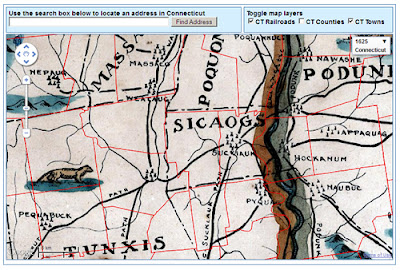 |
| Click the above image to View Interactive Map Mash-up |
Thanks to Benjamin Spaulding for the education and assistance in creating this mash-up!
Also of interest is the following related reading material:
Trumbull, James H. Indian Names of Places, etc. In and On the Borders of Connecticut: With Interpretations of some of them. Hartford : Press of the Case, Lockwood & Brainard Co., 1881
Use the search tool to find instances of the tribes or villages that are featured in the map in the text of James H. Trumbull’s book!
James Hammond Trumbull was born in Stonington, Connecticut in 1821 and died in Hartford, Connecticut in 1897. He was the Assistant Secretary of State for Connecticut, the Connecticut State Librarian, President of the Connecticut Historical Society and was elected to the National Academy of Sciences.
For more information on James Hammond Trumbull, try this link to the National Academies Press.
OK, one map, lots of information. Thanks for stopping by!
~Jeff
How in the World #2
How in the world can the average person access GIS data just as easily as mapping professionals?
In the last “Did You Know?” We introduced GIS (Geographic Information Systems), how it works and what it is used for. Today we would like to show you how to retrieve and view GIS data. You might ask yourself how you can do this without specialized GIS software. No worries, we’ll show you how. All you need is your internet browser!
First, navigate a separate internet browser window to http://magic.lib.uconn.edu/ , once there click on GIS Data located on the top navigation bar
On the next page you will see several icons shaped like the state of Connecticut with categories listed beneath. Today we’re not interested in roads or political boundaries, Brandon and Jeff are going fishing! Jeff knows there are lots of boat launches on the coast but he can’t remember if there is one near Point Bluff State Park. To find out if there is a boat launch click on the Places data category on the right hand side:
This will take you to the places data on the GIS Data page where you’ll find a GIS data layer for Boat Launches! Listed information includes the date, the source (in this case the Connecticut Department of Environmental Protection), and data formats. Today lets preview this data in Google Maps, so on the right hand side of the screen click on the map preview icon:
Your internet browser will now display all of Connecticut’s boat launches in Google Maps:

Let’s check out if Bluff Pont State Park has a boat launch, look at the listing of boat launches on the left, Click on Bluff Point Boat Launch. A balloon will appear on the map giving the location of the boat launch. So we’re done right? We now know that there is a boat launch at Point Bluff State Park. But what if we need bait or fishing tackle while we’re out fishing? Let’s use Google Maps to find out.

On the Bluff Point Boat Launch Balloon, click search nearby. In the text box type Tackle Shop then click the search button.

Google Maps will now display all the tackle shops in the vicinity of the Bluff Point Boat Launch. By clicking on any of the markers a balloon will display the tackle shops name, address, and phone number. You’ll also have the option to get driving directions!

Congratulations, you are now an experienced GIS user! In this exercise you have loaded, queried, and analyzed a GIS data layer! Now you can experiment with MAGIC’s other data layers and have fun making maps. Now you can love geography as much as Brandon and Jeff do!
How in the World?
First the map is selected and brought back to Brandon’s work station
Brandon carefully aligns the map in the scanner so it is nice and straight
After the map has been loaded into the scanner, Brandon tells the computer to scan the image
The scanner sends the digital information to his computer screen where an identical image of the paper map is created
Using software designed to adjust photos and images Brandon makes sure the image is straight and readable. The image is then saved and able to be viewed on computer screens.
In the next “How in the World?” we’ll show you how we give the scanned map geographic reference data so that it can be used in a GIS.
Did You Know? #2
What is GIS an acronym for?
GIS can mean Geographic Information System or Geographic Information Science and both are correct. GIS is a powerful tool that enables geographers and other researchers to:
View
Store,
Manage
And analyze geographically referenced information (maps, imagery, and tables).
The individual components of a GIS that perform the above jobs are:
Computer Hardware, 
Computer Software,
Data,
Methods,
And People.
GIS is an essential tool that allows the graduate students and staff at MAGIC to bring you maps, google mash-ups, and other geographic data.

Jeff and Brandon interpret aerial photography using GIS at MAGIC’s GeoCommons
For more information about GIS visit http://magic.lib.uconn.edu/ or http://www.gis.com/
The University of Connecticut also offers a certificate program in GIS
Map of the Week! London in 1776
London in 1776 (Click link below to view full sized map)
http://www.flickr.com/photos/uconnlibrariesmagic/3789830058/
The featured map this week is a 1776 city map of London, making it as old as the United States! It is found in a book called “A new and universal history, description and survey of the Cities of London and Westminster, the Borough of Southwark, and their adjacent parts” by Walter Harrison. As the title suggests, the book outlines the history of London and contains numerous drawings and maps of the city. There are many interesting locations displayed on the map, including:
London Bridge – Made famous by the nursery rhyme, London Bridge in the late 18th century was one of three places to cross the River Thames in the city. Harrison’s book featured drawings of the bridge in 1776, as well as drawings of when the bridge had buildings on it in the 1750s. London Bridge was torn down and rebuilt in 1831, and then again in 1972. The entire 1831 bridge was purchased in 1968 by an American named Robert McCulloch for two million dollars. McCulloch moved the bridge to Lake Havasu City in Arizona, where it is now the state’s second most popular tourist attraction.
Tower of London
Buckingham Palace – Currently home to the British monarch, Buckingham Palace was simply known as the “Queen’s Palace” in the late 18th century. The palace was greatly expanded and renovated in the early 19th century.
Did You Know?

Introducing Outside the Neatline!
- Featured Map of the Week – The staff’s favorite picks.
- How in the World? – How the graduate students turn paper maps into digital wonders.
- Did You Know? – General geography facts, definitions, and other tasty tidbits.
- And More! – We’re open to suggestions, what do you want to see?
About the Authors:
Jeff Dunn earned his M.A. in Geography at West Virginia University and is currently a PhD student of Geography at the University of Connecticut. During semester breaks he works at MAGIC as a GIS Analyst scanning maps, georeferencing, and developing geography curriculum. Jeff’s specific areas of interests are in remote sensing and coastal geography. Outside of academics, Jeff is an avid fly fisher.
Brandon Cramer is a PhD student in Geography at the University of Connecticut. He received his M.A. in Geography from the University of Connecticut in 2008. Brandon is mainly interested in using geography to examine environmental and health issues. He has worked with government agencies to reduce agricultural pollution and analyze geographic disparities in disease and illness. Over winter and summer breaks Brandon is a GIS Analyst at MAGIC and works on scanning and georeferencing current maps and creating custom maps to fit users’ needs by special request.

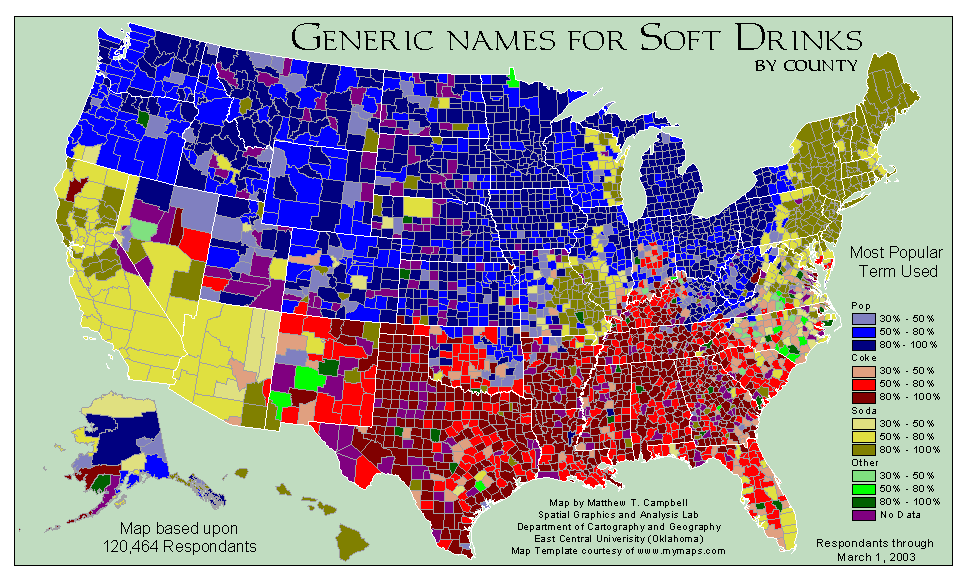




_by_Claes_Van_Visscher.jpg)

